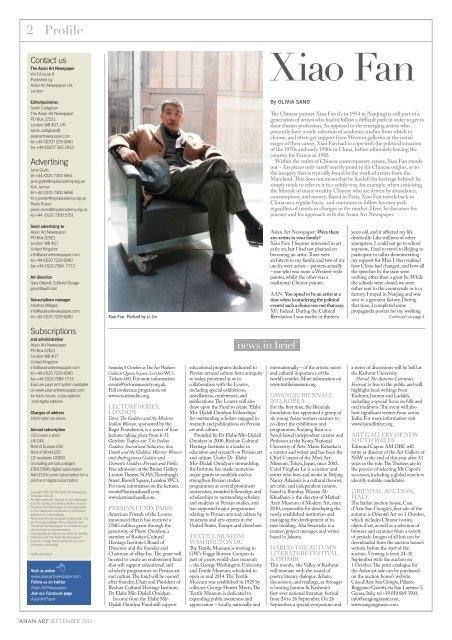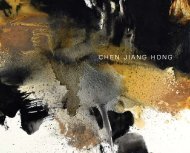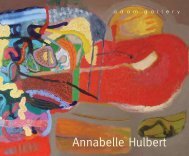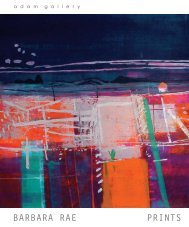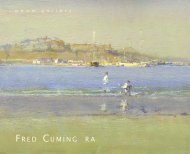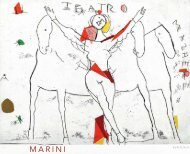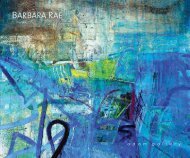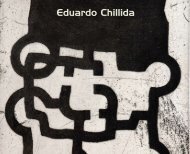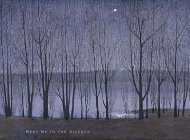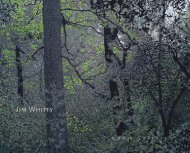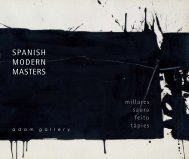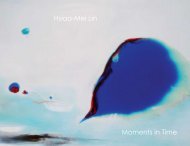Xiao Fan's interview in the Asian Art Newspaper ... - Adam Gallery
Xiao Fan's interview in the Asian Art Newspaper ... - Adam Gallery
Xiao Fan's interview in the Asian Art Newspaper ... - Adam Gallery
Create successful ePaper yourself
Turn your PDF publications into a flip-book with our unique Google optimized e-Paper software.
2<br />
Profile<br />
Contact us<br />
The <strong>Asian</strong> <strong>Art</strong> <strong>Newspaper</strong><br />
Vol 14 Issue 9<br />
Published by<br />
<strong>Asian</strong> <strong>Art</strong> <strong>Newspaper</strong> Ltd,<br />
London<br />
Editor/publisher<br />
Sarah Callaghan<br />
The <strong>Asian</strong> <strong>Art</strong> <strong>Newspaper</strong><br />
PO Box 22521,<br />
London W8 4GT, UK<br />
sarah.callaghan@<br />
asianartnewspaper.com<br />
tel +44 (0)207 229 6040<br />
fax +44 (0)207 565 2913<br />
Advertis<strong>in</strong>g<br />
Jane Grylls<br />
tel +44 (0)20 7300 5661<br />
jane.grylls@royalacademy.org.uk<br />
Kim Jenner<br />
tel +44 (0)20 7300 5658<br />
kim.jenner@royalacademy.org.uk<br />
Paolo Russo<br />
paolo.russo@royalacademy.org.uk<br />
tel +44 (0)20 7300 5751<br />
<strong>Xiao</strong> Fan<br />
By OLIVIA SAND<br />
The Ch<strong>in</strong>ese pa<strong>in</strong>ter <strong>Xiao</strong> Fan (b. <strong>in</strong> 1954 <strong>in</strong> Nanj<strong>in</strong>g) is still part of a<br />
generation of artists who had to follow a difficult path <strong>in</strong> order to get to<br />
<strong>the</strong>ir chosen profession. As opposed to <strong>the</strong> emerg<strong>in</strong>g artists who<br />
presently have a wide selection of academic studies from which to<br />
choose, and often get support from Western galleries at <strong>the</strong> <strong>in</strong>itial<br />
stages of <strong>the</strong>ir career, <strong>Xiao</strong> Fan had to cope with <strong>the</strong> political situation<br />
of <strong>the</strong> 1970s and early 1980s <strong>in</strong> Ch<strong>in</strong>a, before ultimately leav<strong>in</strong>g <strong>the</strong><br />
country for France <strong>in</strong> 1983.<br />
With<strong>in</strong> <strong>the</strong> realm of Ch<strong>in</strong>ese contemporary artists, <strong>Xiao</strong> Fan stands<br />
out – his pieces only rarely overtly po<strong>in</strong>t to his Ch<strong>in</strong>ese orig<strong>in</strong>s, or to<br />
<strong>the</strong> imagery that is typically found <strong>in</strong> <strong>the</strong> work of artists from <strong>the</strong><br />
Ma<strong>in</strong>land. This does not mean that he has left his heritage beh<strong>in</strong>d; he<br />
simply tends to refer to it <strong>in</strong> a subtle way, for example, when criticis<strong>in</strong>g<br />
<strong>the</strong> lifestyle of many wealthy Ch<strong>in</strong>ese who are driven by abundance,<br />
consumption, and money. Based <strong>in</strong> Paris, <strong>Xiao</strong> Fan travels back to<br />
Ch<strong>in</strong>a on a regular basis, and cont<strong>in</strong>ues to follow his own path<br />
regardless of trends or changes <strong>in</strong> <strong>the</strong> market. Here, he discusses his<br />
journey and his approach with <strong>the</strong> <strong>Asian</strong> <strong>Art</strong> <strong>Newspaper</strong>.<br />
Send advertis<strong>in</strong>g to<br />
<strong>Asian</strong> <strong>Art</strong> <strong>Newspaper</strong><br />
PO Box 22521<br />
London W8 4GT<br />
United K<strong>in</strong>gdom<br />
<strong>in</strong>fo@asianartnewspaper.com<br />
tel +44 (0)20 7229 6040<br />
fax +44 (0)20 7084 7713<br />
<strong>Art</strong> direction<br />
Gary Ottewill, Editorial Design<br />
garyottewill.com<br />
Subscriptions manager<br />
Hea<strong>the</strong>r Milligan<br />
<strong>in</strong>fo@asianartnewspaper.com<br />
tel +44 (0)20 7229 6040<br />
<strong>Xiao</strong> Fan. Portrait by Li J<strong>in</strong><br />
<strong>Asian</strong> <strong>Art</strong> <strong>Newspaper</strong>: Were <strong>the</strong>re<br />
any artists <strong>in</strong> your family<br />
<strong>Xiao</strong> Fan: I became <strong>in</strong>terested <strong>in</strong> art<br />
early on, but I had not planned on<br />
becom<strong>in</strong>g an artist. There were<br />
architects <strong>in</strong> my family, and two of my<br />
uncles were artists – pa<strong>in</strong>ters actually<br />
– one who was more a Western-style<br />
pa<strong>in</strong>ter, whilst <strong>the</strong> o<strong>the</strong>r was a<br />
traditional Ch<strong>in</strong>ese pa<strong>in</strong>ter.<br />
AAN: You opted to be an artist at a<br />
time when (consider<strong>in</strong>g <strong>the</strong> political<br />
events) such a choice was not that easy.<br />
XF: Indeed. Dur<strong>in</strong>g <strong>the</strong> Cultural<br />
Revolution I was twelve or thirteen<br />
years old, and it affected my life<br />
drastically. Like millions of o<strong>the</strong>r<br />
youngsters, I could not go to school<br />
anymore, I had to travel to Beij<strong>in</strong>g to<br />
participate <strong>in</strong> rallies demonstrat<strong>in</strong>g<br />
my support for Mao. I <strong>the</strong>n realised<br />
how Ch<strong>in</strong>a had changed, and how all<br />
<strong>the</strong> speeches by <strong>the</strong> state were<br />
noth<strong>in</strong>g o<strong>the</strong>r than a great lie. While<br />
<strong>the</strong> schools were closed, we were<br />
ei<strong>the</strong>r sent to <strong>the</strong> countryside or to a<br />
factory. I stayed <strong>in</strong> Nanj<strong>in</strong>g and was<br />
sent to a garment factory. Dur<strong>in</strong>g<br />
that time, I completed some<br />
propaganda posters for my work<strong>in</strong>g<br />
Cont<strong>in</strong>ued on page 4<br />
Subscriptions<br />
and adm<strong>in</strong>istration<br />
<strong>Asian</strong> <strong>Art</strong> <strong>Newspaper</strong><br />
PO Box 22521<br />
London W8 4GT<br />
United K<strong>in</strong>gdom<br />
<strong>in</strong>fo@asianartnewspaper.com<br />
tel +44 (0)20 7229 6040<br />
fax +44 (0)20 7084 7713<br />
Esecure payment system available<br />
on www.asianartnewspaper.com<br />
for back issues, subscriptions,<br />
and digital editions<br />
Changes of address<br />
Information as above<br />
Annual subscription<br />
(10 issues a year)<br />
UK £45<br />
Rest of Europe £50<br />
Rest of World £55<br />
US residents US$90<br />
(<strong>in</strong>clud<strong>in</strong>g airmail postage)<br />
£30/US$45 digital subscription<br />
Add £10 to pr<strong>in</strong>t subscription for a<br />
pr<strong>in</strong>t and digital subscription<br />
Copyright 2011 © The <strong>Asian</strong> <strong>Art</strong> <strong>Newspaper</strong><br />
The <strong>Asian</strong> <strong>Art</strong> Ltd<br />
All rights reserved. No part of this newspaper<br />
may be reproduced without written consent.<br />
The <strong>Asian</strong> <strong>Art</strong> <strong>Newspaper</strong> is not responsible<br />
for <strong>the</strong> statements expressed <strong>in</strong> contributed<br />
articles and commentaries.<br />
Advertisments are accepted <strong>in</strong> good faith, but<br />
are <strong>the</strong> responsibility of <strong>the</strong> advertiser and<br />
The <strong>Asian</strong> <strong>Art</strong> <strong>Newspaper</strong> is not liable for any<br />
claims made <strong>in</strong> advertisements.<br />
Price guides and values are solely for readers’<br />
reference and The <strong>Asian</strong> <strong>Art</strong> <strong>Newspaper</strong><br />
accepts no legal responsibility for any such<br />
<strong>in</strong>formation published.<br />
ISSN 1460-8537<br />
Visit us onl<strong>in</strong>e<br />
www.asianartnewspaper.com<br />
Follow us on twitter<br />
<strong>Asian</strong> <strong>Art</strong> <strong>Newspaper</strong><br />
Jo<strong>in</strong> our Facebook page<br />
<strong>Asian</strong><strong>Art</strong>Paper<br />
Saturday 8 October at The <strong>Art</strong> Workers<br />
Guild, 6 Queen Square, London WC1.<br />
Tickets £60. For more <strong>in</strong>formation:<br />
events@victoriansociety.org.uk.<br />
Full conference programme on<br />
www.courtstudies.org.<br />
LECTURE SERIES,<br />
LONDON<br />
Devi: The Goddess and <strong>the</strong> Modern<br />
Indian Woman, sponsored by <strong>the</strong><br />
Bagri Foundation, is a series of four<br />
lectures tak<strong>in</strong>g place from 6-31<br />
October. Topics are: The Indian<br />
Goddess: Sacred and Seductive, Sex,<br />
Death and <strong>the</strong> Goddess, Warrior Women<br />
and Androgynous Goddess and<br />
Domestic Goddess: Private and Public.<br />
Free admission at <strong>the</strong> Brunei <strong>Gallery</strong><br />
Lecture Theatre, SOAS, Thornhaugh<br />
Street, Russell Square, London WC1.<br />
For more <strong>in</strong>formation on <strong>the</strong> lectures,<br />
events@katrianahazell.com,<br />
www.katrianahazell.com.<br />
PERSIAN FUND, PARIS<br />
American Friends of <strong>the</strong> Louvre<br />
announced that it has received a<br />
US$3 million grant through <strong>the</strong><br />
generosity of Pierre Omidyar, a<br />
member of Roshan Cultural<br />
Heritage Institute’s Board of<br />
Directors and <strong>the</strong> founder and<br />
Chairman of eBay Inc. The grant will<br />
be used to create an endowment fund<br />
that will support educational and<br />
scholarly programmes on Persian art<br />
and culture. The fund will be named<br />
after founder, Chair and President of<br />
Roshan Cultural Heritage Institute,<br />
Dr Elahé Mir-Djalali Omidyar.<br />
Income from <strong>the</strong> Elahé Mir-<br />
Djalali Omidyar Fund will support<br />
educational programs dedicated to<br />
Persian art and culture from antiquity<br />
to today, presented at or <strong>in</strong><br />
collaboration with <strong>the</strong> Louvre,<br />
<strong>in</strong>clud<strong>in</strong>g special exhibitions,<br />
<strong>in</strong>stallations, conferences, and<br />
publications. The Louvre will also<br />
draw upon <strong>the</strong> Fund to create ‘Elahé<br />
Mir-Djalali Omidyar Fellowships’<br />
for outstand<strong>in</strong>g scholars engaged <strong>in</strong><br />
research and publications on Persian<br />
art and culture.<br />
Founded by Dr Elahé Mir-Djalali<br />
Omidyar <strong>in</strong> 2000, Roshan Cultural<br />
Heritage Institute is a leader <strong>in</strong><br />
education and research on Persian art<br />
and culture. Under Dr Elahé<br />
Mir-Djalali Omidyar’s stewardship,<br />
<strong>the</strong> Institute has made numerous<br />
major grants to establish and/or<br />
streng<strong>the</strong>n Persian studies<br />
programmes at several prom<strong>in</strong>ent<br />
universities, awarded fellowships and<br />
scholarships to outstand<strong>in</strong>g scholars<br />
and students <strong>in</strong> Persian studies, and<br />
has supported major programmes<br />
relat<strong>in</strong>g to Persian arts and culture by<br />
museums and arts centres <strong>in</strong> <strong>the</strong><br />
United States, Europe and elsewhere.<br />
TEXTILE MUSEUM,<br />
WASHINGTON DC<br />
The Textile Museum is mov<strong>in</strong>g to<br />
GW’s Foggy Bottom Campus as<br />
part of a new, world-class museum<br />
– <strong>the</strong> George Wash<strong>in</strong>gton University<br />
and Textile Museum, scheduled to<br />
open <strong>in</strong> mid 2014. The Textile<br />
Museum was established <strong>in</strong> 1925 by<br />
collector George Hewitt Myers, The<br />
Textile Museum is dedicated to<br />
expand<strong>in</strong>g public awareness and<br />
appreciation – locally, nationally and<br />
news <strong>in</strong> brief<br />
<strong>in</strong>ternationally – of <strong>the</strong> artistic merit<br />
and cultural importance of <strong>the</strong><br />
world’s textiles. More <strong>in</strong>formation on<br />
www.textilemuseum.org.<br />
GWANGJU BIENNALE<br />
2012, KOREA<br />
For <strong>the</strong> first time, <strong>the</strong> Biennale<br />
foundation has appo<strong>in</strong>ted a group of<br />
six young <strong>Asian</strong> women curators to<br />
co-direct <strong>the</strong> exhibitions and<br />
programmes. Sunjung Kim is a<br />
Seoul-based <strong>in</strong>dependent curator and<br />
Professor at <strong>the</strong> Korea National<br />
University of <strong>Art</strong>s. Mami Kataoka is<br />
a curator and writer and has been <strong>the</strong><br />
Chief Curator of <strong>the</strong> Mori <strong>Art</strong><br />
Museum, Tokyo, Japan, s<strong>in</strong>ce 2003.<br />
Carol Y<strong>in</strong>ghua Lu is a curator and<br />
writer who lives and works <strong>in</strong> Beij<strong>in</strong>g.<br />
Nancy Adajania is a cultural <strong>the</strong>orist,<br />
art critic and <strong>in</strong>dependent curator,<br />
based <strong>in</strong> Bombay. Wassan Al-<br />
Khudhairi is <strong>the</strong> director of Mathaf:<br />
Arab Museum of Modern <strong>Art</strong>, s<strong>in</strong>ce<br />
2010, responsible for develop<strong>in</strong>g <strong>the</strong><br />
newly established <strong>in</strong>stitution and<br />
manag<strong>in</strong>g <strong>the</strong> development of its<br />
new build<strong>in</strong>g. Alia Swasticka is a<br />
curator, project manager, and writer<br />
based <strong>in</strong> Jakarta.<br />
HARUD: THE AUTUMN<br />
LITERATURE FESTIVAL,<br />
KASHMIR<br />
This month, <strong>the</strong> Valley of Kashmir<br />
will resonate with <strong>the</strong> sound of<br />
poetry, literary dialogue, debate,<br />
discussions, and read<strong>in</strong>gs, as Sr<strong>in</strong>agar<br />
is host<strong>in</strong>g Jammu & Kashmir’s<br />
first-ever national literature festival<br />
from 24 to 26 September. On 26<br />
September, a special symposium and<br />
a series of discussions will be held at<br />
<strong>the</strong> Kashmir University.<br />
Harud: The Autumn Literature<br />
Festival is free to <strong>the</strong> public and will<br />
highlight local writ<strong>in</strong>gs from<br />
Kashmir, Jammu and Ladakh,<br />
<strong>in</strong>clud<strong>in</strong>g a special focus on folk and<br />
oral traditions. The event will also<br />
host significant writers from across<br />
India. For more <strong>in</strong>formation visit<br />
www.harudlitfest.org.<br />
ART GALLERY OF NEW<br />
SOUTH WALES<br />
Edmund Capon AM OBE will<br />
retire as director of <strong>the</strong> <strong>Art</strong> <strong>Gallery</strong> of<br />
NSW at <strong>the</strong> end of this year after 33<br />
years <strong>in</strong> <strong>the</strong> role. The Trustees are <strong>in</strong><br />
<strong>the</strong> process of select<strong>in</strong>g Mr Capon’s<br />
successor, <strong>in</strong>clud<strong>in</strong>g a global search to<br />
identify suitable candidates.<br />
ORIENTAL AUCTION,<br />
ITALY<br />
The Italian auction house, Casa<br />
d’Aste San Giorgio’s, first sale of <strong>the</strong><br />
autumn is Oriental <strong>Art</strong> on 1 October,<br />
which <strong>in</strong>cludes Ch<strong>in</strong>ese ivories,<br />
objets d’art, as well as a selection of<br />
bronzes and ceramics from a variety<br />
of periods. Images of all lots can be<br />
downloaded from <strong>the</strong> auction house’s<br />
website before <strong>the</strong> start of <strong>the</strong><br />
auction. View<strong>in</strong>g is from 24-30<br />
September with <strong>the</strong> auction on<br />
1 October. The pr<strong>in</strong>t catalogue for<br />
<strong>the</strong> <strong>Asian</strong> art sale can be purchased<br />
on <strong>the</strong> auction house’s website.<br />
Casa d’Aste San Giorgio, Palazzo<br />
Boggiano-Gavotti, via San Lorenzo 5,<br />
Genoa, Italy, tel +39 010 869 3500,<br />
<strong>in</strong>fo@sangiorgioaste.com,<br />
www.sangiorgioaste.com.<br />
ASIAN ART SEPTEMBER 2011
4<br />
Profile<br />
unit, as well as for <strong>the</strong> neighbourhood.<br />
My wish, never<strong>the</strong>less, rema<strong>in</strong>ed <strong>the</strong><br />
same: to cont<strong>in</strong>ue my academic<br />
studies and to go to university. Once<br />
<strong>the</strong> political situation began to<br />
change after Mao passed away <strong>in</strong><br />
1976, I could f<strong>in</strong>ally apply to sit <strong>the</strong><br />
admissions exam for <strong>the</strong> teacher’s<br />
college <strong>in</strong> Nanj<strong>in</strong>g. I chose <strong>the</strong> f<strong>in</strong>e<br />
arts department, where I learned<br />
many different th<strong>in</strong>gs rang<strong>in</strong>g from<br />
calligraphy and Ch<strong>in</strong>ese pa<strong>in</strong>t<strong>in</strong>g to<br />
Western pa<strong>in</strong>t<strong>in</strong>g techniques. At <strong>the</strong><br />
time, Nanj<strong>in</strong>g was a medium-sized<br />
city, and <strong>the</strong> art school – as well as<br />
<strong>the</strong> university – had a long tradition.<br />
I was taught by two different types of<br />
professor: ones who had studied <strong>in</strong><br />
Europe and o<strong>the</strong>rs who had studied<br />
<strong>in</strong> <strong>the</strong> former Soviet Union. A few of<br />
<strong>the</strong>m had also studied <strong>in</strong> Japan. I<br />
graduated <strong>in</strong> <strong>the</strong> spr<strong>in</strong>g of 1983, and<br />
by October of <strong>the</strong> same year, I had<br />
left Ch<strong>in</strong>a for France.<br />
AAN: Did you not consider stay<strong>in</strong>g<br />
<strong>in</strong> Ch<strong>in</strong>a <strong>in</strong> 1983, as <strong>the</strong> country was<br />
beg<strong>in</strong>n<strong>in</strong>g to change<br />
XF: In my op<strong>in</strong>ion, at that time<br />
(and for me as an artist), it had not<br />
changed that much. When I<br />
graduated, I had acquired good<br />
techniques <strong>in</strong> pa<strong>in</strong>t<strong>in</strong>g. However, I<br />
did not get <strong>the</strong> best possible grades,<br />
because I was already start<strong>in</strong>g to<br />
experiment with abstract pa<strong>in</strong>t<strong>in</strong>g<br />
which was a great <strong>in</strong>fluence on my<br />
work. Yet, <strong>in</strong> 1983, it was not<br />
well-received to venture <strong>in</strong>to modern<br />
art. From <strong>the</strong> beg<strong>in</strong>n<strong>in</strong>g, however, I<br />
rema<strong>in</strong>ed faithful to <strong>the</strong> medium of<br />
pa<strong>in</strong>t<strong>in</strong>g, even if <strong>the</strong>re were times<br />
when <strong>in</strong>stallations seemed much<br />
more popular.<br />
AAN: What made you choose<br />
France<br />
XF: Initially, <strong>the</strong> US was <strong>the</strong><br />
dest<strong>in</strong>ation of choice, but th<strong>in</strong>gs<br />
began to change, and more and more<br />
artists chose to settle <strong>in</strong> France ra<strong>the</strong>r<br />
<strong>the</strong>n <strong>the</strong> US. Personally, I opted for<br />
France because I had met French<br />
students at <strong>the</strong> University of Nanj<strong>in</strong>g,<br />
and <strong>the</strong>y played an important role<br />
encourag<strong>in</strong>g me to go to France.<br />
Orig<strong>in</strong>ally, I was supposed to rema<strong>in</strong><br />
at <strong>the</strong> Ecole des Beaux-<strong>Art</strong>s <strong>in</strong> Paris<br />
for one year, but ultimately, I decided<br />
to stay because, at <strong>the</strong> same time,<br />
<strong>the</strong>re were not that many possibilities<br />
<strong>in</strong> Beij<strong>in</strong>g. I had an offer <strong>in</strong> Ch<strong>in</strong>a<br />
for a position as an art professor <strong>in</strong> a<br />
newly built university <strong>in</strong> Suzhou, but<br />
I wanted to cont<strong>in</strong>ue pa<strong>in</strong>t<strong>in</strong>g.<br />
Consequently, and although this<br />
proposition was actually <strong>in</strong>terest<strong>in</strong>g,<br />
I decided to stay <strong>in</strong> Paris.<br />
AAN: You had graduated from art<br />
school <strong>in</strong> Nanj<strong>in</strong>g before com<strong>in</strong>g to<br />
Paris. What did go<strong>in</strong>g through<br />
ano<strong>the</strong>r art curriculum at <strong>the</strong> Ecole<br />
des Beaux-<strong>Art</strong>s add to your practice<br />
XF: Stay<strong>in</strong>g at <strong>the</strong> Ecole des<br />
Beaux-<strong>Art</strong>s was based on practical<br />
reasons. In order to stay <strong>in</strong> France<br />
legitimately, I changed my status<br />
from be<strong>in</strong>g a student to be<strong>in</strong>g an<br />
artist. Recently, <strong>the</strong>re have been many<br />
changes affect<strong>in</strong>g <strong>the</strong> school <strong>in</strong> a very<br />
positive way. As much as <strong>in</strong> <strong>the</strong><br />
1980s <strong>the</strong> school was ra<strong>the</strong>r limited<br />
on many levels; from 1984, it began<br />
to re<strong>in</strong>vent itself. Daniel Buren, for<br />
example, created an <strong>in</strong>stitute<br />
choos<strong>in</strong>g some artists to study one<br />
year under his guidance. I thought<br />
that was very <strong>in</strong>terest<strong>in</strong>g, but this<br />
new curriculum only started once I<br />
had already left <strong>the</strong> school. Today, <strong>the</strong><br />
schools’ strategy is much better<br />
def<strong>in</strong>ed, aim<strong>in</strong>g at show<strong>in</strong>g dist<strong>in</strong>ctly<br />
how to become an artist, and what it<br />
means to be an artist.<br />
AAN: As opposed to many of your<br />
contemporaries from Ch<strong>in</strong>a, your<br />
No.1 (2011), oil on canvas, 100 x 82 cm<br />
Bubble Game No 18<br />
work is not immediately recognisable<br />
as ‘be<strong>in</strong>g Ch<strong>in</strong>ese’.<br />
XF : In <strong>the</strong> beg<strong>in</strong>n<strong>in</strong>g of <strong>the</strong> 1980s,<br />
my work had a Ch<strong>in</strong>ese touch<br />
(Ch<strong>in</strong>ese <strong>in</strong>k, Ch<strong>in</strong>ese calligraphy,<br />
etc.), but eventually that all<br />
disappeared. I guess that us<strong>in</strong>g<br />
imagery that immediately suggests<br />
that <strong>the</strong> artist is from Ch<strong>in</strong>a is also a<br />
strategy to get attention. I have<br />
thought about that, and not only <strong>in</strong><br />
<strong>the</strong> context of Ch<strong>in</strong>a. I greatly<br />
enjoyed <strong>the</strong> book written by François<br />
Cheng – Empty and Full: <strong>the</strong><br />
Language of Ch<strong>in</strong>ese Pa<strong>in</strong>t<strong>in</strong>g. I try to<br />
adapt this idea beyond <strong>the</strong> canvas, to<br />
<strong>the</strong> practical side of life. If one does<br />
everyth<strong>in</strong>g white with just a small<br />
coloured dot, it is empty and at <strong>the</strong><br />
same time full which I f<strong>in</strong>d nice, but<br />
a little bit too easy. When I pa<strong>in</strong>t, I<br />
want to th<strong>in</strong>k how and why I am<br />
fill<strong>in</strong>g <strong>the</strong> canvas <strong>the</strong> way I do. In<br />
that sense, I want to f<strong>in</strong>d ano<strong>the</strong>r way<br />
to expla<strong>in</strong> <strong>the</strong> depth of <strong>the</strong> void. You<br />
can never clearly def<strong>in</strong>e it. It helps<br />
when you look at a pa<strong>in</strong>t<strong>in</strong>g. For me,<br />
pa<strong>in</strong>t<strong>in</strong>g needs to be read on a<br />
long-term basis. It should not be like<br />
love at first sight, where noth<strong>in</strong>g<br />
more substantial develops after <strong>the</strong><br />
<strong>in</strong>itial sparkle. I want people to keep<br />
discover<strong>in</strong>g new th<strong>in</strong>gs and new<br />
mean<strong>in</strong>gs <strong>in</strong> my pa<strong>in</strong>t<strong>in</strong>gs.<br />
AAN: You said earlier that you were<br />
also tra<strong>in</strong>ed <strong>in</strong> traditional calligraphy.<br />
Is that someth<strong>in</strong>g you could imag<strong>in</strong>e<br />
go<strong>in</strong>g back to<br />
XF: No, I do not th<strong>in</strong>k I will get<br />
back to calligraphy. If time allows, I<br />
like to practise it, but to me,<br />
calligraphy is almost like a<br />
meditat<strong>in</strong>g process.<br />
AAN: Besides your pa<strong>in</strong>t<strong>in</strong>gs, you<br />
have also completed a small series of<br />
sculptures. How did you get to<br />
develop sculpture<br />
XF: I have completed a series of<br />
pa<strong>in</strong>t<strong>in</strong>gs <strong>in</strong>volv<strong>in</strong>g flowers, <strong>in</strong><br />
reference to <strong>the</strong> Hundred Flowers<br />
Campaign. After work<strong>in</strong>g on many,<br />
I realised that I wanted to complete<br />
some flowers that would be more<br />
powerful than <strong>the</strong> ones <strong>in</strong> my<br />
pa<strong>in</strong>t<strong>in</strong>gs, someth<strong>in</strong>g more real and<br />
au<strong>the</strong>ntic. Sculpture <strong>the</strong>refore<br />
became <strong>the</strong> natural choice. However,<br />
as I had never studied sculpture, I<br />
needed to rely on <strong>the</strong> help of some<br />
students <strong>in</strong> Nanj<strong>in</strong>g helped me with<br />
<strong>the</strong> process. I have completed 12,<br />
some small, and would like to do<br />
some more <strong>in</strong> <strong>the</strong> future. The size of<br />
sculpture does not really matter to<br />
me, for example, I enjoy <strong>the</strong> work of<br />
Giuseppe Penone (b. 1947 <strong>in</strong> Italy),<br />
Enjoy No 17 (2007), 250 x 200 cm<br />
I have rema<strong>in</strong>ed<br />
faithful to <strong>the</strong><br />
medium of pa<strong>in</strong>t<strong>in</strong>g,<br />
even if <strong>the</strong>re were<br />
times when<br />
<strong>in</strong>stallations seemed<br />
much more popular<br />
who has also done some small th<strong>in</strong>gs,<br />
yet <strong>the</strong>y are still very powerful. Our<br />
approach is very similar, and I guess<br />
one could almost talk about a<br />
Buddhist or an Oriental approach.<br />
The dimensions of a sculpture do not<br />
affect its weight and mean<strong>in</strong>g. I have<br />
a clear preference for sculpture, as<br />
opposed to <strong>in</strong>stallation.<br />
AAN: Many artists from Ch<strong>in</strong>a<br />
have recently been criticised as <strong>the</strong>ir<br />
work seems to have more to do with<br />
a factory production than with a<br />
solitary artist complet<strong>in</strong>g his pieces.<br />
Do you rely a great deal on <strong>the</strong> help<br />
of assistants<br />
XF: For pa<strong>in</strong>t<strong>in</strong>gs, I do not like to<br />
work with assistants, except if it were<br />
for a very important public<br />
commission where one depends on<br />
help. To me, pa<strong>in</strong>t<strong>in</strong>g is like <strong>the</strong> work<br />
of a writer, and <strong>the</strong>re is more to it<br />
than keep<strong>in</strong>g a group of assistants<br />
busy. Pa<strong>in</strong>t<strong>in</strong>g is a dialogue between<br />
<strong>the</strong> canvas and <strong>the</strong> artist. For me,<br />
pa<strong>in</strong>t<strong>in</strong>g is a long journey, and I want<br />
to cont<strong>in</strong>ue it, even if that implies<br />
advanc<strong>in</strong>g slowly.<br />
AAN: You had two museum<br />
exhibitions <strong>in</strong> Ch<strong>in</strong>a. How did <strong>the</strong><br />
Ch<strong>in</strong>ese react to your pieces that are<br />
sometimes - even if not overtly -<br />
quite critical of <strong>the</strong> present Ch<strong>in</strong>ese<br />
lifestyle<br />
XF: In 2004 and 2005, I met a few<br />
overseas Ch<strong>in</strong>ese collectors. They<br />
kept po<strong>in</strong>t<strong>in</strong>g out that <strong>the</strong>re were not<br />
any Ch<strong>in</strong>ese elements <strong>in</strong> my<br />
pa<strong>in</strong>t<strong>in</strong>gs! They could not understand<br />
how, as a Ch<strong>in</strong>ese pa<strong>in</strong>ter, I could<br />
complete pa<strong>in</strong>t<strong>in</strong>gs without add<strong>in</strong>g<br />
certa<strong>in</strong> items that made <strong>the</strong> pa<strong>in</strong>t<strong>in</strong>g<br />
identifiable as com<strong>in</strong>g from a<br />
Ch<strong>in</strong>ese artist. To me, that does not<br />
mean that I have forgotten about<br />
Ch<strong>in</strong>ese civilisation. On <strong>the</strong> contrary!<br />
AAN: Why did you create <strong>the</strong> Mao<br />
series In all your o<strong>the</strong>r work <strong>the</strong>re is<br />
no overt reference to any specifically<br />
Ch<strong>in</strong>ese imagery.<br />
XF: In 2006, it was <strong>the</strong> 30th<br />
anniversary of Mao’s death.<br />
Understandably, and like millions of<br />
o<strong>the</strong>r Ch<strong>in</strong>ese people, I was directly<br />
concerned by <strong>the</strong> consequences of<br />
<strong>the</strong> Cultural Revolution. My fa<strong>the</strong>r,<br />
and my family, all endured a lot of<br />
hardship, even dur<strong>in</strong>g <strong>the</strong> Hundred<br />
Flowers Campaign. Once <strong>the</strong><br />
communists came to power, my<br />
grandfa<strong>the</strong>r was arrested <strong>in</strong> 1954 or<br />
1955, and sentenced to 25 years <strong>in</strong><br />
prison. He came out of prison <strong>in</strong><br />
1976, or 1977, and passed away one<br />
year later. We all suffered a lot, and<br />
dur<strong>in</strong>g my childhood as well as my<br />
studies, many th<strong>in</strong>gs were refused to<br />
me for <strong>the</strong> simple reason that after<br />
assess<strong>in</strong>g my family, <strong>the</strong> conclusion<br />
was <strong>in</strong>evitably <strong>the</strong> same: that I came<br />
from a bad (from a ‘black’ family).<br />
Personally, it was a long struggle until<br />
1976, as dur<strong>in</strong>g that time I had to<br />
work <strong>in</strong> a small factory, and was not<br />
allowed to change jobs.<br />
Regard<strong>in</strong>g my series based on <strong>the</strong><br />
imagery of Mao, l knew many artists<br />
would be work<strong>in</strong>g on someth<strong>in</strong>g<br />
similar, but I never<strong>the</strong>less wanted to<br />
create someth<strong>in</strong>g with him as<br />
centrepiece. I would not say that <strong>the</strong><br />
work is about him. It is ma<strong>in</strong>ly about<br />
authority. Although we presently<br />
have more freedom <strong>in</strong> Ch<strong>in</strong>a, I do<br />
not th<strong>in</strong>k th<strong>in</strong>gs will ever completely<br />
change. Up to now, we could never<br />
openly discuss everyth<strong>in</strong>g we have<br />
been through under <strong>the</strong> Mao era.<br />
Even today, if one wants to publish a<br />
catalogue <strong>in</strong>volv<strong>in</strong>g many images of<br />
Mao – even if <strong>the</strong>y are positive – one<br />
needs to have authorisation. Today,<br />
why can we not have a political<br />
open<strong>in</strong>g <strong>in</strong> Ch<strong>in</strong>a Because we<br />
cannot openly discuss history, or<br />
what has happened over <strong>the</strong> past<br />
decades. It is <strong>the</strong> entire system that<br />
cannot be touched. This is a<br />
prerequisite for chang<strong>in</strong>g any o<strong>the</strong>r<br />
area of Ch<strong>in</strong>ese society. Deng<br />
<strong>Xiao</strong>p<strong>in</strong>g said that everyth<strong>in</strong>g would<br />
be so different for us. That is not <strong>the</strong><br />
case! Com<strong>in</strong>g back to my work on<br />
Mao, I put a condom over him,<br />
which is a way to show that he is<br />
preserved. One can certa<strong>in</strong>ly touch<br />
him, but one cannot really touch<br />
him.<br />
AAN: Look<strong>in</strong>g at your latest work,<br />
is <strong>the</strong> human figure becom<strong>in</strong>g more<br />
important<br />
XF: Yes, def<strong>in</strong>itely. I do not want to<br />
submit myself to <strong>the</strong> trends of<br />
contemporary art, especially to <strong>the</strong><br />
trends of Ch<strong>in</strong>ese contemporary art.<br />
I want to f<strong>in</strong>d simple th<strong>in</strong>gs to pa<strong>in</strong>t,<br />
that I f<strong>in</strong>d always have more<br />
mean<strong>in</strong>g <strong>in</strong> order to have a<br />
conversation about our society.<br />
AAN: What message should your<br />
pa<strong>in</strong>t<strong>in</strong>gs convey<br />
XF: I f<strong>in</strong>d that a lot of art today is<br />
similar to somebody wear<strong>in</strong>g an<br />
oversized garment, which<br />
consequently seems a little empty. I<br />
would like to have someth<strong>in</strong>g more<br />
profound upon people can reflect.<br />
<strong>Art</strong> is not propaganda. I would like<br />
people, when <strong>the</strong>y see <strong>the</strong> pieces, to<br />
f<strong>in</strong>d a message for everyday life. To<br />
me, art is someth<strong>in</strong>g quite<br />
philosophical, and quite poetic.<br />
I like to keep my voice even if it<br />
goes aga<strong>in</strong>st <strong>the</strong> stream. I would like<br />
people to keep see<strong>in</strong>g th<strong>in</strong>gs <strong>in</strong> my<br />
pa<strong>in</strong>t<strong>in</strong>gs, new th<strong>in</strong>gs or th<strong>in</strong>gs <strong>the</strong>y<br />
had forgotten that <strong>the</strong>y now see<br />
under a different angle. Which leads<br />
me to underl<strong>in</strong>e that noth<strong>in</strong>g is ever<br />
completely new: <strong>the</strong>re are simply<br />
th<strong>in</strong>gs that we have forgotten or<br />
th<strong>in</strong>gs that are now presented <strong>in</strong> a<br />
different way.<br />
ASIAN ART SEPTEMBER 2011


